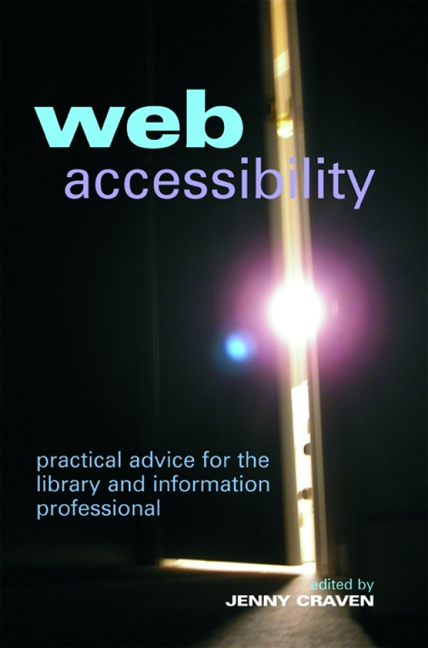Book contents
- Frontmatter
- Contents
- Contributors
- 1 Introduction
- 2 Tools used for widening access to the web
- 3 Design for All – how web accessibility affects different people
- 4 The importance of web accessibility
- 5 Accessibility advice and guidance
- 6 Accessibility evaluation and assessment
- 7 Issues for library and information services
- 8 Design for All in the library and information science curriculum
- 9 Best practice examples of web accessibility
- 10 Web accessibility in the future
- Index
7 - Issues for library and information services
Published online by Cambridge University Press: 08 June 2018
- Frontmatter
- Contents
- Contributors
- 1 Introduction
- 2 Tools used for widening access to the web
- 3 Design for All – how web accessibility affects different people
- 4 The importance of web accessibility
- 5 Accessibility advice and guidance
- 6 Accessibility evaluation and assessment
- 7 Issues for library and information services
- 8 Design for All in the library and information science curriculum
- 9 Best practice examples of web accessibility
- 10 Web accessibility in the future
- Index
Summary
Introduction
The practical implications of the need to ensure web accessibility are not always straightforward to assess. Few if any in the profession would argue against the aim of achieving as accessible a web presence as possible, but there is a variety of constraints which make achieving this objective difficult. Not least, libraries and information services have limited budgets and, much as staff may like to provide fully accessible services and equipment, the reality is that it is always a matter of choosing between conflicting demands. What is more, few libraries can afford to employ staff dedicated solely to accessibility and expert in its many ramifications: it is one requirement among many. Where, then, to start?
In this chapter it is suggested that a useful way forward is to adopt a sevenfold strategy:
Spend time listening to representatives of users and potential users, and couple this intelligence with sound professional judgement. If possible, conduct user testing of website features. Consider the users, the web-based services and the environments in which use will occur as a whole. In this way a picture can be built up of the library's specific user requirements, rather than the theoretical needs of every possible user group.
Become familiar with the key sources of advice and guidance, selectively concentrating on those which are most relevant to this user population.
Develop an accessibility policy for the library service that addresses the particular needs of its users.
Audit the existing web presence, including finding out which are the most visited pages and services (and thus the ones most in need of verification).
Introduce those changes which, the evidence suggests, will have maximum impact, and make the sometimes small adjustments that will benefit as many users as possible at minimum cost. (This will require judgement based on the mapping of the user requirements to guidelines and professional advice.)
Provide appropriate assistive technologies that meet the particular needs of the library's community.
Continually monitor and review what is being achieved, not least by continuing to listen to what the users, and the non-users, are saying.
- Type
- Chapter
- Information
- Web AccessibilityPractical Advice for the Library and Information Professional, pp. 97 - 112Publisher: FacetPrint publication year: 2008

